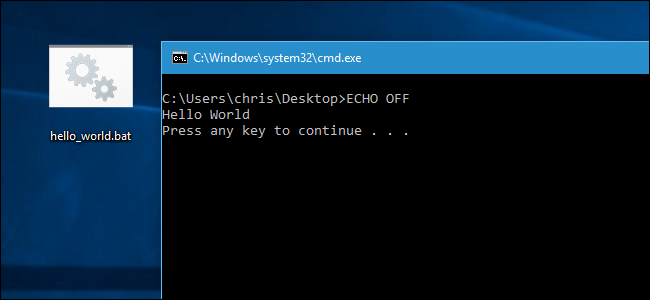

- #What is the file extension for mac that is equivelent to a .bat on windows? code
- #What is the file extension for mac that is equivelent to a .bat on windows? windows
The user can use this indirection to access subdirectories too. cd dir (without a /) will put the user in a subdirectory for example, if they are in /usr, typing cd bin will put them in /usr/bin, while cd /bin puts them in /bin.cd ~ username will put the user in the username's home directory.will place their shell in the recreated directory.

#What is the file extension for mac that is equivelent to a .bat on windows? code
This can be useful if the user's shell's internal code can't deal with the directory they are in being recreated running cd. will leave the user in the same directory they are currently in (i.e.
#What is the file extension for mac that is equivelent to a .bat on windows? windows
Modern versions of Windows simulate this behaviour for backwards compatibility under CMD.EXE. C: alternatively, cd with the /d switch may be used to change the working drive and that drive's working directory in one step. Typing the drive letter as a command on its own changes the working drive, e.g. The cd command can be used to change the working directory of the working drive or another lettered drive. Workreports games encyclopedia text.txt cd user is now in the "games" directory.Ī similar session in DOS (though the concept of a "home directory" may not apply, depending on the specific version ) would look like this:ĭOS maintains separate working directories for each lettered drive, and also has the concept of a current working drive. The cd command can be used to change into a subdirectory, move back into the parent directory, move all the way back to the root directory or move to any given directory.Ĭonsider the following subsection of a Unix filesystem, which shows a user's home directory (represented as ~) with a file, text.txt, and three ls Directories may also contain other directories. Of course, this is not true for legacy commands which still run in a separate process.Ī directory is a logical section of a file system used to hold files. NET Framework and has a different architecture than previous shells, all of PowerShell's cmdlets like ls, rm etc. However, since PowerShell is based on the. Windows PowerShell, Microsoft's object-oriented command line shell and scripting language, executes the cd command ( cmdlet) within the shell's process. If the cd command inherits the parent process' directory, then the objective of the command cd will never be achieved. This is because, when a new process is created, child process inherits the directory in which the parent process was created. Instead, the shell itself executes this command. This means that when the command is executed, no new process is created to migrate to the other directory as is the case with other commands such as ls. The system call that effects the command in most operating systems is chdir that is defined by POSIX.Ĭommand line shells on Windows usually use the Windows API to change the current working directory, whereas on Unix systems cd calls the chdir() POSIX C function. This is the case in most of the Unix shells ( Bourne shell, tcsh, bash, etc.), cmd.exe on Microsoft Windows NT/ 2000+ and Windows PowerShell on Windows 7+ and COMMAND.COM on DOS/ Microsoft Windows 3.x- 9x/ ME. Ĭd is frequently included built directly into a command-line interpreter. The command is analogous to the Stratus OpenVOS change_current_dir command.

The command is also available in the open source MS-DOS emulator DOSBox and in the EFI shell. DR DOS 6.0 also includes an implementation of the cd and chdir commands. On MS-DOS, it is available in versions 2 and later. The command has been implemented in operating systems such as Unix, DOS, IBM OS/2, MetaComCo TRIPOS, AmigaOS (where if a bare path is given, cd is implied), Microsoft Windows, ReactOS, and Linux.


 0 kommentar(er)
0 kommentar(er)
